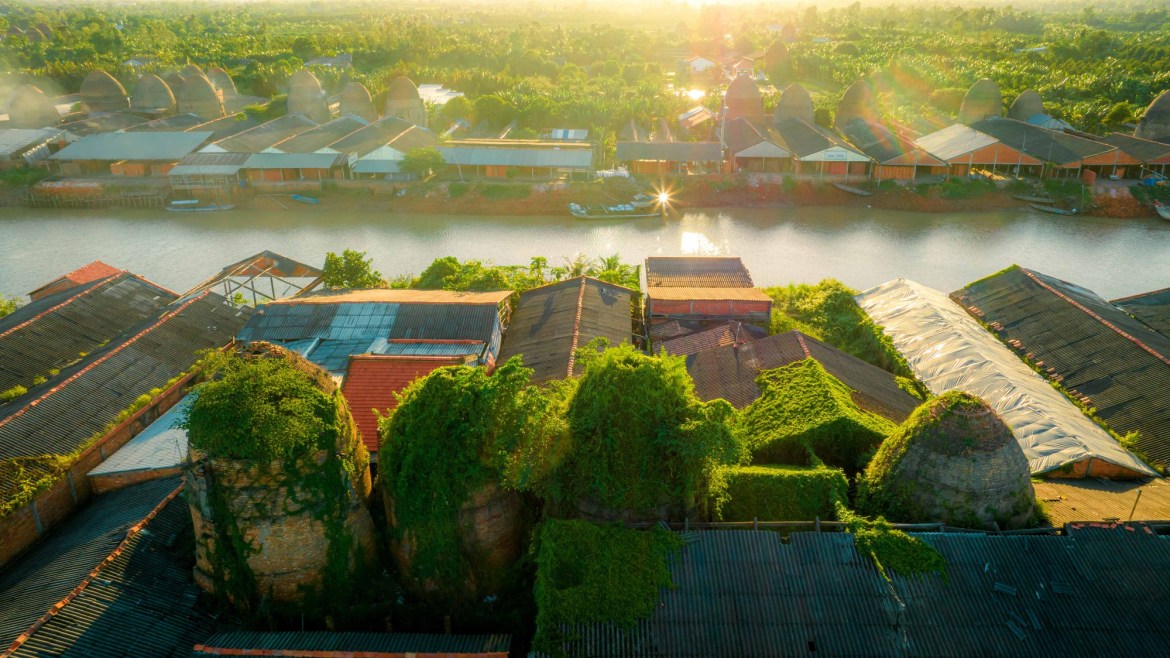The Mekong Delta’s rivers serve a dual purpose – they provide nutrient-rich alluvium to the region’s fruit fields and orchards, and they also create flexible clay, which is crucial to the ceramic brick industry. While some of the area’s furnaces are now dilapidated and covered in moss and dust, they possess a timeless beauty.
The canal used to be bustling with boats ferrying raw materials and goods to and from the furnaces during prosperous times. Most of the products manufactured here are transported all over and exported to countries like Cambodia, Korea, and Thailand, making Mang Thit the largest producer of ceramic tiles in the Southwest.

The brick kilns in Mang Thit are built mainly with thousands of card bricks, forming architecture with a height of 9 – 13m. The furnace has a diameter of about 6 – 8m, is cylindrical, and gradually becomes smaller at the top.
Local kiln owners have mentioned that producing high-quality bricks requires numerous steps and more than a month. The clay is first kneaded and shaped into bricks before being dried. Nowadays, machines assist in this stage, making the process faster and less complex. Once the bricks are dry, it takes approximately 7 to 10 days to place them in the kiln. This step requires skilled individuals to ensure that the bricks cook evenly from top to bottom, despite the fire being lit only from below.

During its heyday in the 1980s, the whole “kingdom” had more than 1,000 production facilities with about 3,000 furnaces operating continuously.

Raw materials such as firewood and rice husks are continuously heated for 20 days in an active brick kiln to achieve high-quality bricks.
The brick-making profession in Mang Thit has gradually declined due to the unsuitability of traditional materials such as husk and firewood for social development, as well as the increased cost of raw materials. As a result, many families have replaced it with other occupations. Nevertheless, the unique architecture of the Mang Thit brick kiln has become a popular destination, attracting visitors from afar who come to take photos and learn about traditional crafts.

Currently, the Thay Cai canal area is where the most brick kilns remain in the Mang Thit district with nearly 1,000 kilns close together.

The old brick kilns are covered with green moss.
To capitalize on this interest, Vinh Long province has decided to preserve the old brick kilns and establish cultural, artistic, and tourism programs centered around them. The “Mang Thit Contemporary Heritage” project, with a total investment of around 200 billion VND from 2021 to 2025, aims to transform this place into an appealing attraction on the Mekong Delta tourism map.
To reach the Co Chien riverside area, head straight for about 10 km from My Thuan bridge to the Dinh Khao ferry. This area is home to many brick kilns. After that, continue on provincial road 902 for more than 10 km until you reach the Thay Cai bridge. From here, you can see the “kingdom of ceramic tiles” on both banks of the Thay Cai River. Feel free to explore, take photos, and enjoy the sights.
@thanhnien.vn
Related
Source: Vietnam Insider
